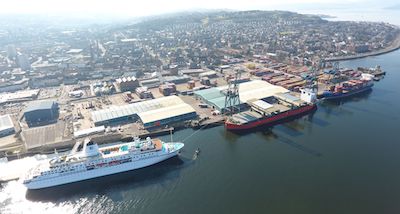Scotland’s First Minister Humza Yousaf has announced the transfer of the Clyde Mission regeneration programme to the Glasgow City Region as Scottish Government investment in the plan reaches more than £40 million.
The transfer takes place as Scottish Government talks are to begin with local leaders on formally recognising the eight local authorities involved as a “metro-region.”
The Clyde Mission has been working since 2020 to transform the riverside corridor running from Lanarkshire, through the City of Glasgow, to the sea.
An additional £1.5 million will be dedicated to the masterplan project, taking the Scottish Government’s overall investment to more than £40 million.
This includes £25 million of previously announced funding for heat decarbonisation projects that is being awarded to the partner local authorities.
The Clyde Mission seeks to “recognise and use the River Clyde as a national, strategic asset.”
It focuses on using the land immediately adjacent to the river — within around 500 metres — as a national strategic asset and follows the Clyde from its origins in the Lowther hills through to the opening of the river between Gourock and Dunoon.
The new funding will provide Glasgow City Region and Argyll & Bute Council with an investment over three years (2023-26) for the development of a masterplan which will set out plans for stimulating growth.
The Scottish Government said it has provided £13.6 million through Clyde Mission to 13 different projects within the Clyde Mission footprint.
“Migration of the Clyde Mission is a prime example of the Scottish Government’s commitment to empowering and devolving more decision making to all of Scotland’s regions,” said the Scottish Government.
“Discussions aimed at enabling successful regional economies focused on property and wellbeing will continue to be rolled out with all regional economic partnerships across Scotland.”
First Minister Humza Yousaf said: “As Scotland’s largest city, Glasgow’s success is fundamental to our success as a nation and our drive to create a wellbeing economy that is fair, green and growing.
“When Glasgow’s grows, Scotland grows – and by working in partnership with a stronger city region, we will make sure we realise its economic potential.
“We are transferring responsibility over the running of Clyde Mission from the Scottish Government to empower the city region, helping to attract new investment, create jobs and deliver prosperity and wellbeing for communities from Argyll to the Clyde Valley.
“I am committed to working with the leaders in Glasgow region to explore all options for how the Scottish Government can work with them to boost the regional economy – from our joint work with the UK Government on an investment zone in the city, to engaging with them directly on their aspirations to be formally recognised as a metropolitan region.
“The city region is brimming with economic potential – from life sciences to renewables, from space to tourism, the regional economy is one of great strength and diversity. By working in partnership with a stronger city region, we will make sure we realise that potential.”
Councillor Susan Aitken, Leader of Glasgow City Council and Chair of the Glasgow City Region Cabinet, said: “This is a major step forward in the devolution of power to Scotland’s biggest city region, the only genuine metropolis in these islands north of Manchester.
“The handover to the eight local authorities of the responsibility to progress what remains the greatest untapped development opportunity in western Europe, provides many of the levers we need to address growth, productivity and the wellbeing of the 1.8 million citizens of the City Region, and to tackle the ingrained social and economic inequalities within many of Scotland’s most deprived communities.
“That is real transformational potential and allows us to seize the opportunity to accelerate one of the UK’s most diverse and competitive city regions and secure our aim of becoming its most innovative, inclusive and resilient economy by 2030.”
